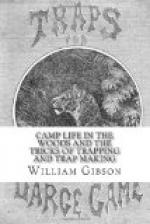The Gopher is a great pest to western cultivators, and by its root feeding and undermining propensities does extensive injury to crops generally. They may be successfully trapped in the following manner: Strike a line between the two most recent earth mounds, and midway between them remove a piece of the sod. By the aid of a trowel or a sharp stick the burrow may now be reached. Insert your hand in the tunnel and enlarge the interior sufficiently to allow the introduction of No. (0) steel trap. Set the trap flatly in the bottom of the burrow, and then laying a piece of shingle or a few sticks across the excavation replace the sod. Several traps may be thus set in the burrows at considerable distances apart, and a number of the animals thus taken. The traps are sometimes inserted in the burrows from the hillocks, by first finding the hole and then enlarging it by inserting the arm and digging with the hand beneath. The former method, however, is preferable.
The skin of the Gopher may be pulled off the body either by cutting up the hind less, as described in reference to the Fox, [Page 207] or by making the incision from the lower jaw down the neck, as decided for the muskrat, a simple board stretcher being used.
THE MOLE.
Of all the mammalia the Mole is entitled to take the first place in the list of burrowers. This extraordinary creature does not merely dig tunnels in the ground and sit at the end of them, as is the case with many animals, but it forms a complicated subterranean dwelling place with chambers, passages and other arrangements of wonderful completeness. It has regular roads leading to its feeding grounds; establishes a system of communication as elaborate as that of a modern railway, or, to be more correct, as that of the subterranean network of the sewers of a city. It is an animal of varied accomplishments. It can run tolerably fast, it can fight like a bull-dog, it can capture prey under or above ground, it can swim fearlessly, and it can sink wells for the purpose of quenching its thirst. Take the mole out of its proper sphere, and it is awkward and clumsy as the sloth when placed on level ground, or the seal when brought ashore. Replace it in the familiar earth and it becomes a different being, full of life and energy, and actuated by a fiery activity which seems quite inconsistent with its dull aspect and seemingly inert form.
We all know that the mole burrows under the ground, raising at intervals the little hillocks or “mole hills” with which we are so familiar; but most of us little know the extent or variety of its tunnels, or that the animal works on a regular system and does not burrow here and there at random. How it manages to form its burrows in such admirably straight lines, is not an easy problem, because it is always done in black darkness, and we know of nothing which can act as a guide to the animal. As for ourselves and other eye-possessing creatures, the feat of walking in a straight line with closed eyelids is almost an impossibility, and every swimmer knows the difficulty of keeping a straight course under water, even with the use of his eyes.




